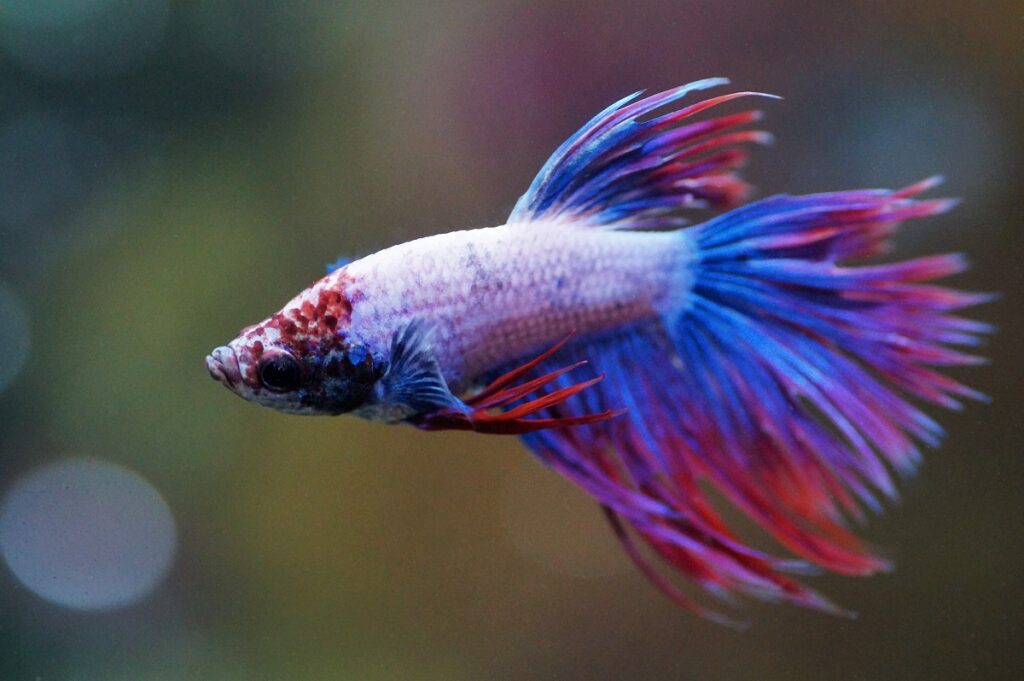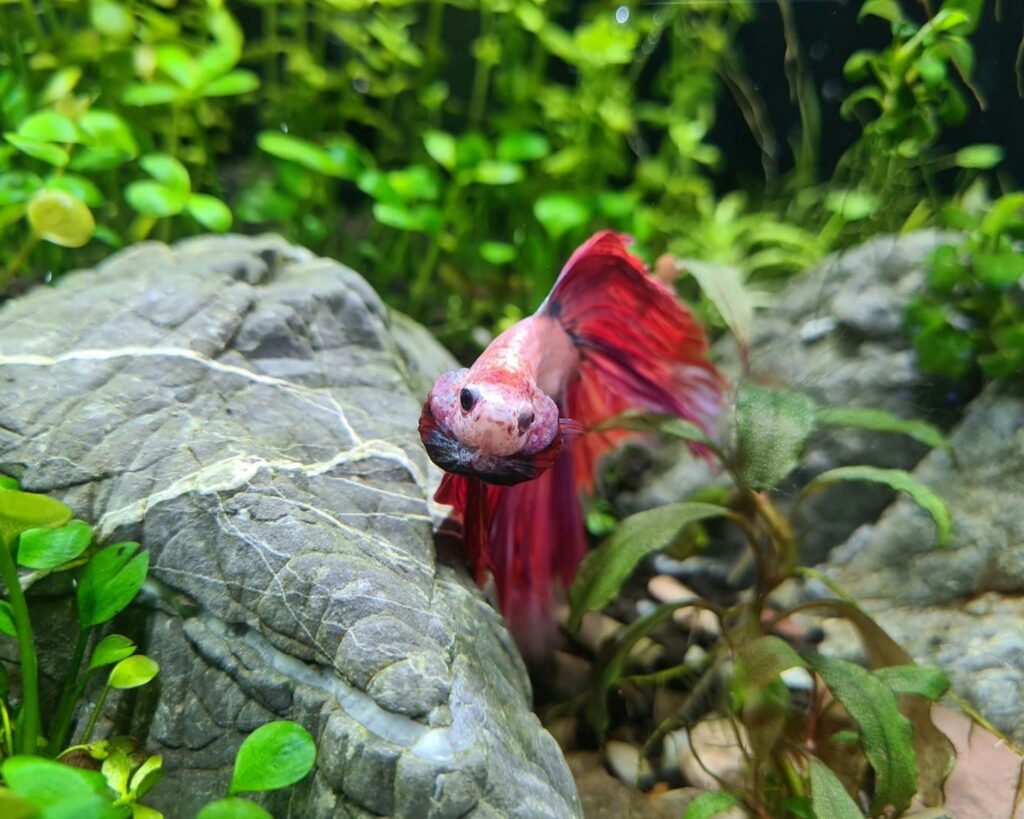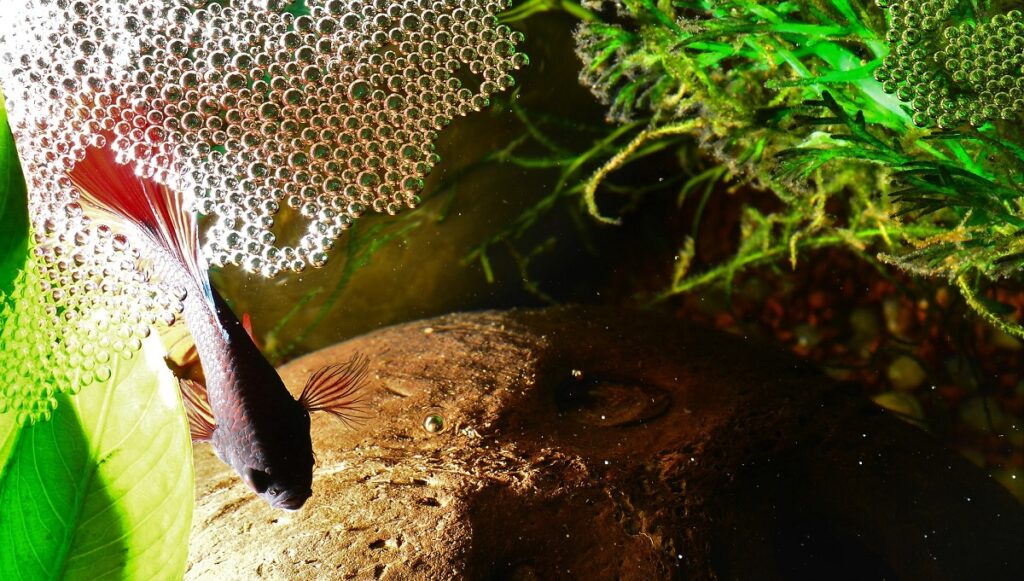The Ultimate Betta Fish Care Guide
Looking for a colorful fish to add to your aquarium? The Betta fish (Betta splendens), available in a veritable rainbow of different hues, is the perfect pocket pet for small tanks. It's easy to care for and beginner-proof, although it does have some specific requirements to keep in mind.
Below, find out everything you need to know about Betta fish, where they're from, and how to make sure yours thrives for years to come!
| Scientific name | Betta splendens |
| Common names | Betta fish, Siamese fighting fish, fighter fish |
| Difficulty level | Easy |
| Origin | Southeast Asia |
Table of Contents
Betta fish appearance & natural habitat
Appearance
Betta splendens, better known as the Siamese fighting fish or simply "Betta," is one of the most popular aquarium fish for good reason. This species is small, reaching no more than 3" in length, but it's highly colorful and just stunning to look at. It sports an elongated body and an upturned mouth.
Most Betta fish available in local aquarium stores are males. This is because, in their natural underwater world, males must woo females, so they have evolved to be more colorful and have longer fins. During territorial fights and when a breeding partner is present, they spread their fins and open their gill covers, similar to peacocks flaring, to show off.
Our pet Bettas have been bred for extra-flowy fins in different shapes, all with their own names:
- Veiltail: Long, flowy fins and tail that trail behind the fish like a veil
- Halfmoon: Long but less flowy fins, with a tail that forms a half circle while flared
- Plakat: Short-finned and closer to the Betta's ancestors
- Crowntail: Reduced webbing between fin rays, giving a comb-like look
- Rosetail: Excessive webbing between fin rays, which gives a feathery look but can impede swimming
- Double tail: Two smaller tail fins as the result of a genetic mutation
- Delta tail: Long tail that's not flowy but also doesn't extend to a full half circle
- Dumbo: Similar to a plakat, but with enlarged pectoral fins
Aside from their spectacular fins, Bettas also gained huge popularity thanks to their colors. They can be red, blue, purple, white, black, yellow, orange, and more. And it's not just solid coloration either—there are too many different patterns out there to even try to discuss here, and even fish with unusual or iridescent scales.
Did you know? Although ornamental Bettas are scientifically called Betta splendens, they're actually hybrids. Wild B. splendens is a dark reddish, short-finned fish with some green-blue color on the fins. The current array of colors and fin shapes was achieved through selective breeding and by mixing B. splendens with closely related species, like B. smaragdina and B. imbellis.
Natural habitat
Some pet stores still cling to the belief that Betta fish are naturally from tiny puddles, often as an excuse to sell them for extreme nano aquariums and bowls. It would be nice if a fish existed that could survive in these, but alas! Although the waters our Bettas would naturally inhabit are shallow, they're not isolated.
Wild Betta splendens are found in Thailand, where they are unfortunately considered to be a Vulnerable species by the IUCN Red List as a result of habitat degradation for agriculture and urbanization. They mostly inhabit swampland, preferring nice and shallow waters with a low flow level and plenty of vegetation. They can also be found in rice paddies.
Because the water in Bettas' natural habitat is usually shallow and very warm, it tends to be very low in dissolved oxygen. Luckily, this species belongs to a family called the Anabantoidei. Also known as labyrinth fish, members of this family have an extra, lung-like organ near their gills that allows them to supplement the oxygen they get from the water with oxygen from the air. Yes, they can breathe!
Wild Bettas are highly antisocial fish. They're pretty much entirely solitary, with the males defending large patches of water and plants they consider their territory. That's why they're also called fighting fish. In fact, the Thai originally started keeping them as pets in order to bet on (almost always non-fatal) fights between the males.
Did you know? The name "Betta" is pronounced "bet-tah", not "bay-ta".

Setting up a Betta fish aquarium
Requirements
When setting up an aquarium for a Betta fish, it's important to keep this species' natural habitat in mind. As we've discussed, they don't live in mini puddles. Although tiny tanks, vases, and bowls are a popular choice, your Betta won't thrive in these. For the best results, we highly recommend going for a 5-gallon aquarium (or 10+ if you would like to add any tankmates).
The tank should have a filter and a heater to ensure the water quality stays in order (see below). The light should be relatively dim and the filter set to low, as a strong flow will stress out these long-finned fish and blow them all over the tank. There should always be a lid on the tank, but be sure not to fill it all the way to the top. Your Betta can suffocate if it's unable to breathe air!
Additionally, the aquarium should be densely planted. Those Thai marshlands are full of water lilies, floating plants, and riparian vegetation! You can add some floaters to diffuse the light, stem plants to break the lines of sight, and moss for a fun accent. Finish off the aquascape with your favorite types of natural rocks and driftwood.
Avoid "Betta mirrors", as these will trick your fish into thinking a rival male is present. The constant perception of threat will stress it out, sometimes even to the point of refusing to eat.
Did you know? Many aquarists swear by adding some leaf litter to their Betta tanks. It's definitely something they'd encounter in the wild, and the tannins released by the leaves are antimicrobial and believed to be beneficial to the health of our fish. The Shrimp Farm approves!
Water parameters
One of the reasons Bettas are so incredibly suitable as aquarium fish is the fact that they're highly adaptable. We've already discussed their labyrinth organ, which allows them to supplement their oxygen intake by breathing air.
On top of this, Betta fish are able to withstand a wide range of water parameters. For example, although the water in their natural habitat is usually somewhat soft and acidic, its pH can also rise drastically. Temperatures can fluctuate and the water quality may be low in the dry season.
It's easy to fall into the trap of believing that all this means you don't have to stay on top of aquarium maintenance if you keep a Betta. While it is true that they're a little more forgiving to beginner mistakes than other, more sensitive species, they still can't thrive in dirty water. And keep in mind that our ornamental pet store Bettas can be more sensitive than their wild cousins due to inbreeding!
Like all other fish, Bettas should only be introduced into a fully cycled aquarium. You should use a water conditioner and perform weekly small water changes in order to prevent a build-up of harmful compounds.
pH: 6-8
Temperature: 72-86 °F
TDS: 20-250
Tankmates
Pay close attention here! One of the most important things you need to know about Betta fish is that they are not a suitable choice for the average community aquarium. Multiple Bettas should never be kept together, as even the females are aggressive towards their own kind.
As for other tankmates, there are some possibilities, but they are limited. Consider this: Bettas will attack anything that looks too much like another Betta, and they're sure to nibble on long antennae or flowy fins. On the other hand, they're also vulnerable to fin-nipping themselves, and will become stressed if they're kept with more boisterous, active species.
So what does that leave us with? Well, if you want to play it safe, you can just keep your Betta on its own; it won't be lonely, but actually prefers things this way. Otherwise, you'll have to look for inoffensive species that neither make a good target for the Betta nor will target it themselves.
There are a few suitable bottom feeders:
- Dwarf Corydoras catfish (Corydoras pygmaeus, hastatus & habrosus)
- Kuhli loaches (Pangio kuhlii & oblonga)
- Asian stone catfish (Hara jerdoni)
- Otocinclus catfish
For the middle water layer, small and not too brightly colored species will work:
- Phoenix rasbora (Boraras merah)
- Kubotai rasbora (Microdevario kubotai)
- Ember tetra (Hyphessobrycon amandae)
Lastly, you could add some invertebrates:
- Nerite snails (Vittina sp., Clithon sp.)
- Amano shrimp (Caridina multidentata)
- Ghost shrimp (Palaemonetes sp.)
- Dwarf crayfish (Cambarellus sp.)
- Cherry shrimp (Neocaridina davidi)
Betta fish diet
The Betta's upturned mouth reveals what it eats: bugs. In the wild, insects that fall on the water surface are quickly scooped up, as are any larvae, worms, and other invertebrates that are unlucky enough to come across a Betta fish.
In the aquarium, you can feed your Betta a high-quality microfood as a staple. Both pellets and flakes are fine as long as they're tiny and formulated for carnivores. Frozen foods also work well. If you want to see your fish display its natural hunting instincts, you can try live food:
- Wingless fruit flies
- Daphnia
- Baby brine shrimp
- Bloodworms
Don't overfeed your Betta, as they're prone to obesity-related problems like fatty liver disease, which can really shorten their lifespans. You can offer 3-5 Betta pellets twice a day (or the same amount of worms, fruit flies, etc.). Don't cave when your fish appears to "beg" for food, especially if its tummy is looking nice and round!
Breeding Betta fish
Yep, you can breed Bettas in your home aquarium! In fact, many aquarists consider it a fun and rewarding hobby, especially once one begins to understand Betta genetics and how to achieve certain colors and fin shapes in the offspring.
You can find everything you need to know about getting your Betta fish to reproduce in the article on Betta bubble nests and breeding.
Did you know? A bubble nest is exactly what it sounds like: a floating nest of bubbles in which the eggs are laid and baby Bettas spend their first few days. Male Betta fish, even solo ones, can often be seen building and guarding their homemade nests in a quiet corner of the aquarium.
Buying a Betta fish
Because they're so popular, every pet or aquarium store will carry at least a few different Betta colors and fin shapes. Unfortunately, many of these are mass produced in less-than-ideal conditions, so they may have shorter lifespans as a result of inbreeding and genetic defects.
If you'd like to start your own Betta breeding project or are worried about your pet fish dying prematurely (healthy specimens can live for up to 5 years in exceptional cases!), it's best to find a hobbyist breeder. Their stock is usually healthier.



 Shrimp
Shrimp Fish
Fish Crab &
Crab & Plants
Plants Foods
Foods Snails
Snails


